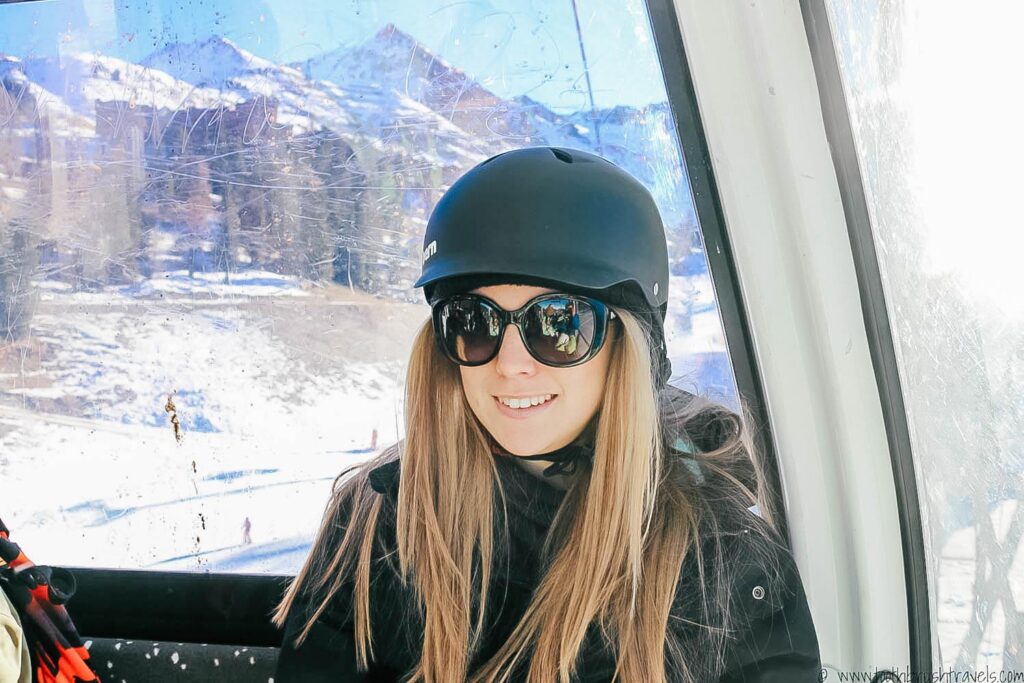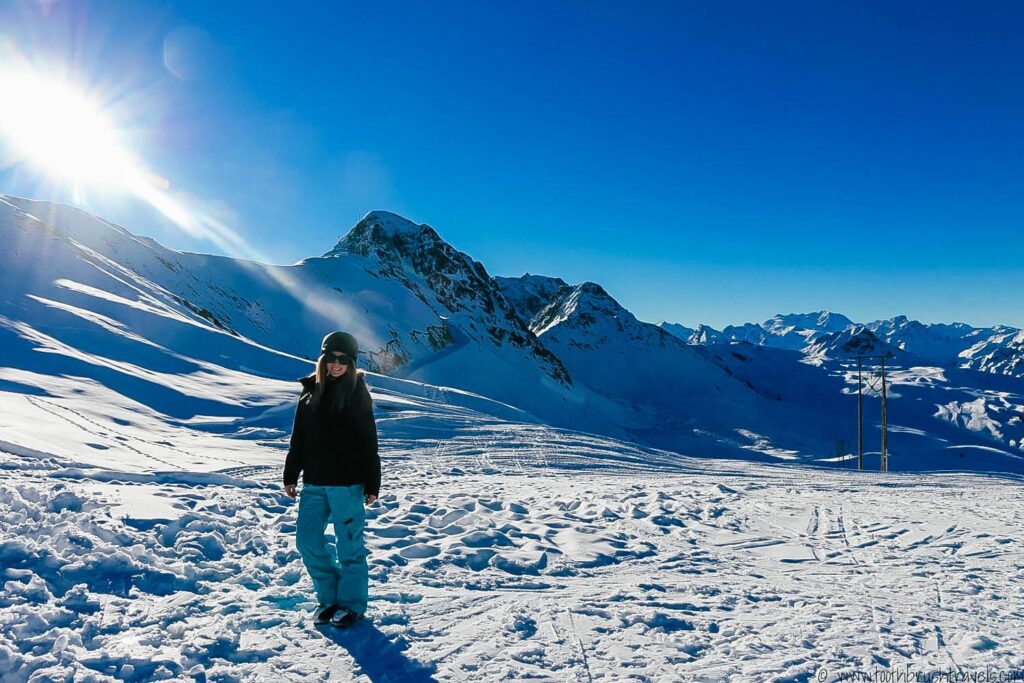Planning a winter vacation but not sure what to add to your ski trip checklist? Don’t worry, we’ve all been there. Packing for a trip to the slopes can be a daunting thing, especially if you’ve never been before—there’s always that fear that you’ve forgotten something.
But don’t worry, in this post I’ll talk you through the ski trip checklist I use every year to ensure I always pack my favourites and never forget the essentials. Let’s start with the basics.

Clothing
I’m pretty sure you already know to pack warm layers because there’s snow so obviously it’s cold. But when skiing/snowboarding, you’ll be spending hours outside so you don’t just want to be warm, you want to be comfortable. The best thing for this is to use breathable fabrics, starting with your base layers (thermals). There are numerous brands out there but they’re basically like skin-tight pyjamas which you get to wear all day. They’re comfortable, keep you warm, and are totally acceptable to wear around the chalet after a day out on the slopes when you can’t be bothered to change.
Base layers are completely affordable and you can find pairs for as little as £20. But in my opinion, it’s worth investing because a good pair of base layers will last you years, but a cheap pair not only isn’t as effective at keeping you warm but tends to wear out very quickly.
What base layers do I pack?
I have a few different brands and the ones I use depend on the weather. If the sun’s out I pretty much just ski in thermals, salopettes and my coat and because I tend to get super warm so don’t need mid-layers, and on these days I wear Helly Hansen dry layers. But on days where it’s super cold I wear Under Armour compression layers then layer them with a t-shirt, fleece, and buff too. Because I’m not about that cold life.
What socks do I pack?
You’d think that this wouldn’t matter so much, throw on any pair of socks and you’re good to go. But that couldn’t be farther from the truth. Because having the right socks can really affect how much you love or hate skiing because it affects your comfort so much. For example, if you’re skiing and you have calf muscles, wearing super thick socks isn’t always the best option due to the way that ski boots sit. Whereas if you’re snowboarding, this is less of a problem. Because of this, I always wear a specific type of knee-high socks when skiing: Salomon ski socks. They have slight padding on the shin and are elasticated meaning that they don’t tend to fall down.
What clothing do I pack?
Honestly, the same type that I’d wear on a winter’s day in England. Typically made up of a t-shirt or cami, trousers and a cardigan or jumper and loungewear for being at the chalet/hotel. Most places you visit when skiing will have central heating pumping and so you’ll want to layer your items so it’s easy to remove them when you get too hot. And for the rest—just ensure you have a nice warm coat! Especially when walking back, as once the sun goes down the temperatures drop significantly.

Equipment
Your skip trip checklist for equipment will depend upon two things: whether you’re planning to ski or snowboard, and whether you own or rent your equipment. If you’re planning on snowboarding, you’ll need a board, bindings and snowboard boots. If you’re planning on skiing, you’ll need skis, bindings, ski boots and poles. Renting these items is super easy and can usually be arranged by your accommodation, or by visiting a rental shop which is typically positioned in every resort. But outside of that, you’ll want to consider packing the following:

What helmet do I pack?
Safety is key when you’re on the slopes. Helmets may not be the coolest looking things but Natasha Richardson, Michael Schumacher and an old job as an International Assistance Coordinator for a travel insurance company have shown me that a helmet can be the difference between life and death. You can rent a helmet but if you know you’ll be going skiing regularly it’s worth investing in your own. There are various companies which sell helmets, but when you’re looking you’ll need to pick a style that fits well because let’s face it, a helmet that doesn’t fit is about as useful as a chocolate teapot.
I have the Bern Watts EPS in Matte Black with the quilted audio liner. Not only do their helmets fit me well and comply with all of the safety standards, but they’re the only brand I have found that doesn’t leave me looking like a total egg. In addition to this, it has numerous vents and the lining is not only super comfortable on my ears (unusual given there are headphones inside!) but it goes to a decent length on your neck so it’s warmer than some other variants.

What goggles do I pack?
Goggles are a never-ending way to spend your money. There are so many different shapes and shades to choose from it can be nerve-wracking knowing where to start. I know this because when it came to choosing mine I didn’t have a clue. Different lenses achieve different outcomes and so the conditions will be predominant in which you choose. For example:
- If it’s bright and sunny then you’ll need a dark-coloured lens.
(Grey, dark brown, black/silver mirrored or blue)
Darker lenses mean less light will come into your googles enabling you to see more which is great because the more visibility you have the better you’ll be at judging distance, which is definitely a requirement. Snow blindness is a real thing and there’s nothing worse than not being able to see where the dips and bumps are when racing down a black run! - For foggy or poor conditions you’ll need a light-coloured lens.
(Pink, red, yellow, amber, gold or green)
Lighter lenses mean that more light comes into your goggles, which helps enable you to assess depth perception, contrast and the ability to see shapes and objects in darker areas (which is really quite handy if you ever get stuck in a whiteout!).
The first pair I ever bought was a cheap and cheerful pair with orange lenses and honestly, I gave no thought to them when buying. But my second pair is amazing. They’re the Oakley Stockholm Goggles with a lightly mirrored lens and I am obsessed. When skiing I tend to take both goggles and sunglasses and decide what to wear depending on the conditions. If it’s bright, sunny and not snowing then I’ll wear my sunglasses and if it’s snowing, foggy or, well, just damn cold, then I wear my goggles.
What salopettes do I pack?
Salopettes are sold everywhere. You can get them directly from the brand’s websites, you can find them on various retailers or you can pop into your local TK Maxx and find some there too. But the thing with salopettes is there are multiple styles. You can buy them tight, baggy, high-waisted, low-waisted, long or calf-length. There’s literally a style and pattern for everyone, so it’s best to try them on.
I’ve always been a total DC fan when it comes to snow gear because I love the way their styles fit me. They’re baggy without swamping me, they’re warm, and they’re comfortable. I wear the DC Ace snowboard pants in Harbor Blue. My current pair are from last season and were a total steal from TK Maxx, costing me just half the price of what they retail for. There are multiple pockets for you to fill with all the Maoam and Curly Wurlys, and have a few zips which you can open for breathability. I also have them in black and have a different pair in orange, green and blue but to be honest, I typically stick to the above. Although, I have just added some Poivre Blanc to my collection—and it’s the first time ski pants have made my butt look good!
What buff/scarf do I pack?
A buff is a scarf/headwear which can be worn 13 different ways. For me, it’s vital in keeping the chill off my neck or if it’s a total whiteout then I’m probably going to wear my entire head in it so that my hair doesn’t freeze. A small but simple item of clothing with so many different uses and by far one of my favourite products! I use a windproof neck-warmer Buff which is half Goretex and half fleece. It’s warm. It’s snug. And it’s easy to pull up over your nose when you’re stuck on a windy chairlift because somebody’s fallen off whilst disembarking.

What gloves do I pack?
An obvious choice but one that’s hard to get right. Gloves or mittens? Tight or loose fit? Thick or thin? Again this one is down to personal preference! I used to ride with a beautiful pair of quilted white gloves made by Barts. They were like 6 years old but I adored them. Unfortunately, when I last went skiing I somehow managed to turn the liner inside out when taking them off and neither I nor five other people could get the material back into the shell so I gave up. Obviously, I couldn’t ski without gloves so on a little night-time trip to La Plagne, I picked up a pair of gloves from a French brand called Racer. Despite the name they did nothing to help my racing abilities, but they did keep my hands warm, so ya’know, that’s good.
What boots do I pack?
Ahh, snow boots, the multi-purpose shoe of joy. You were built for all terrains, from prattling about on the slopes to dancing all night as you apres-ski. You pretty much won’t need any other shoe because, well, ice, so when you’re picking a snow boot you’ll want something comfy.
I used to use O’Neill Meribel boots which were comfortable, waterproof and had good grip but didn’t remain tight around my legs and so I got a pair of Joan of Arctic by Sorel.

What backpack do I pack?
A backpack isn’t a necessity. You probably have enough pockets in your jacket and your salopettes for all of your secret snacks, but if you like having the option of somewhere to store your layers then a backpack is your best bet. There are a variety of options on backpacks but you’ll want one with either a chest or waist strap as nothing ruins a great run like a backpack flailing about behind you.
I don’t normally ski with a backpack because if I’m honest it’s a pain in the arse for me having to lug stuff around, but this year I wanted to take my DSLR out to play and so I got the Lowepro transit and it was everything I wanted from a backpack and more. Not only does the Transit have a snug layout perfect for my camera, but it has seat-belt style straps that ensure the pack stays close to your back. In addition to this, it’s a sling-style pack which means that when you undo one of the straps you can swing the pack around to your front making it super convenient when you want to whip out your camera or sit on a chair lift in comfort.
By using the above checklist, you can rest assured knowing that you have everything you need—and it comes in handy for packing things up at the end of your trip too, as you know you haven’t forgotten anything!
